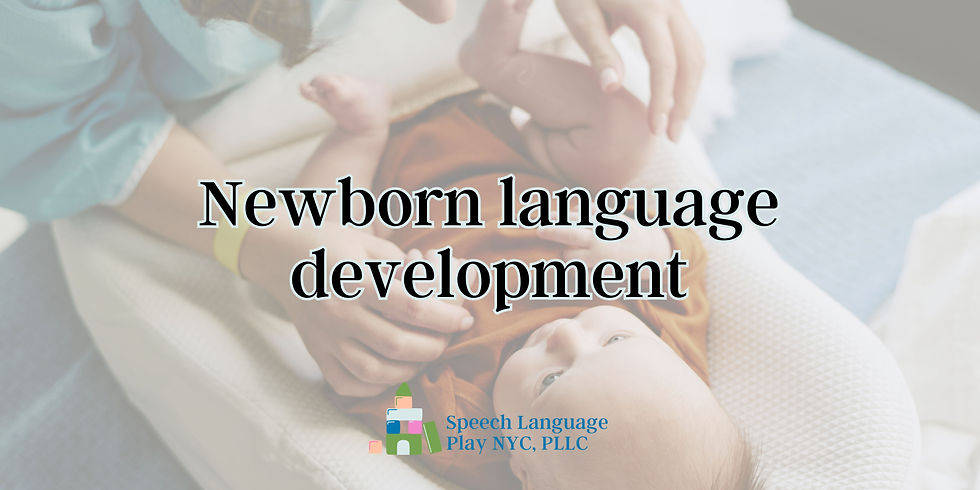Creating a language-rich environment
- Abby Long

- Feb 20, 2024
- 3 min read

Creating a language-rich environment for your child can be crucial for fostering their speech and language development at home. Although hitting those speech and language milestones is a HUGE deal, there's a whole lot of groundwork to lay before that! Your child's language development depends on many factors, but the most crucial one is...their environment! Want to create a language paradise that will make your child's vocabulary bloom? Let's explore what we can do at home to make it happen!
What is a language-rich environment?
Creating a language-rich environment doesn't need to be difficult! This type of environment refers to a setting that provides ample opportunities for children to be exposed to a thoughtfully designed space that actively promotes and encourages the enhancement of children's communication and language! In such an environment, language is valued, encouraged, and integrated into various aspects of daily life.
Developing Your Child's Vocabulary: Key Points to Keep In Mind
When talking to your child throughout the following activities, it's important to use a reduced rate of speech and speak clearly. Using rich vocabulary will help broaden their vocabulary as well. Your child will learn by listening, watching, exploring, copying, responding, initiating, playing, and interacting with those around them. Spending quality time with your child and providing a shared focus is crucial to fostering their speech, language, and social abilities!
Why is creating a language-rich environment important?
Creating a language-rich environment is crucial for supporting language development, communication skills, and overall cognitive growth. Here are three effective ways for parents to provide such an environment:
1. Read Aloud Regularly:
Reading aloud is one of the most powerful ways to expose your child to language. Choose a variety of books with colorful pictures, engaging stories, and simple text suitable for your child's age. Reading together not only introduces new vocabulary to your child, but also helps them understand the structure of sentences and narratives.
Tips:
Start reading to your child from an early age, even if they are too young to understand the words. The rhythmic pattern of your voice and exposure to language are beneficial.
Ask open-ended questions about the story, encouraging your child to express their thoughts and opinions ("Oh she looks sad! Why do you think she feels sad?" "Where do you think the Gruffalo is going next?" etc.)
Repeat favorite stories; repetition is a valuable tool for language development. It is OKAY - and encouraged - to read a book over and over!
2. Engage in Conversations:
Regular conversations with your child provide them with opportunities to practice and expand their language skills. Engage in meaningful discussions about their day, interests, and observations. Be an active listener, responding to their comments and questions to show that their words are valued.
Tips:
Use open-ended questions to stimulate conversation, allowing your child to express themselves more freely ("How was your day with Mrs. Smith today?" vs. "Did you have a good day?").
Pay attention to nonverbal cues, such as gestures and facial expressions, and respond appropriately ("I can tell you really enjoyed doing that with her today!").
Introduce new words during conversations, providing context for their meaning ("So it sounds like you especially loved seeing the lion today in his big enclosure at the zoo. An enclosure is where the zoo animals live at the zoo!").
3. Create a Language-Enriched Play Environment:
Play is a natural way for children to explore language and communication. Incorporate toys and activities that encourage verbal interaction, imaginative play, and the use of different words. This can include games, puzzles, and role-playing scenarios that spark your child's creativity.
Tips:
Use toys that involve labeling objects and actions, promoting vocabulary development. For example, playing with dolls and action figures allows your child to create dialogues and scenarios. Model this vocabulary and dialogue for your child as you play together. They will learn a lot by listening to you and observing!
Incorporate educational games that focus on language skills, such as matching games with pictures, colors, and words.
Encourage your child to describe their play experiences, fostering the ability to express thoughts and feelings.
Get comfortable following their lead! Engage in activities THEY especially love!
Encourage role-play activities: not only does it open up a world of imagination, but it's also a great way to sneak in a whole lot of new words and phrases into their environment!
By consistently implementing these practices, parents can contribute significantly to the development of their child's language skills. Remember that the key is creating a supportive and interactive environment where language is not only present but celebrated. And have fun!
If you're concerned about your child's current speech and language milestones, reach out to us here for a free 15-minute consultation!




Comments